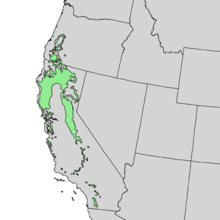Quercus kelloggii
| Quercus kelloggii | |
|---|---|
 |
|
| Scientific classification | |
| Kingdom: | Plantae |
| (unranked): | Angiosperms |
| (unranked): | Eudicots |
| (unranked): | Rosids |
| Order: | Fagales |
| Family: | Fagaceae |
| Genus: | Quercus |
| Section: | Lobatae |
| Species: | Q. kelloggii |
| Binomial name | |
|
Quercus kelloggii Newb. 1859 |
|
 |
|
| Natural range | |
| Synonyms | |
|
|
Quercus kelloggii, the California black oak, also known as simply black oak, or Kellogg oak, is an oak in the red oak section (Quercus sect. Lobatae), native to western North America. It is a close relative of the black oak (Quercus velutina) found in eastern and central North America.
California black oak is a deciduous tree growing in mixed evergreen forests, oak woodlands, and Coniferous forests. California black oak is distributed along foothills and lower mountains of California and western Oregon.
It is found from Lane County, Oregon, south through the Cascade Range, the Sierra Nevada, and the Coast, Transverse, and Peninsular ranges to San Diego County, California and into Baja California. The tree occurs in pure or mixed stands. Pure stands usually indicate sites unfavorable to conifer growth or recurring disturbance such as fire or logging activities. The tree can grow in many types of soils, but it is important that the soil be well-drained.
Quercus kelloggii typically grows from 9–25 m (30–82 ft) in height and from 0.3–1.4 m (0.98–4.59 ft) in diameter. Large trees may exceed 36 m (118 ft) in height and 1.6 m (5.2 ft) diameter. The species also grows in shrubby scrub-oak form on poor sites. In open areas the crown is broad and rounded, with lower branches nearly touching the ground or forming a browse line. In closed stands, the crown is narrow and slender in young trees and irregularly broad in old trees. Trunks are usually free of branches on the lower 6–12 m (20–39 ft) in closed stands. Trunks are often forked, and usually decayed and hollow in older trees. The bark is thin and smooth in young trees, becoming thick, ridged, and plate-like with age. This oak grows from one to several vertical roots which penetrate to bedrock, with large, laterally spreading roots extending off from vertical ones. It also has a number of surface roots.
...
Wikipedia
